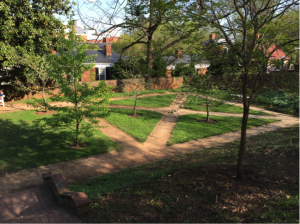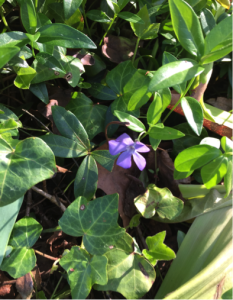My name is Trevor Ruegg and I am a second-year student from California. I am posting on behalf of the Edible Trees & Plants team.
Since first walking through the gardens during my first few weeks at UVA, the abundance of different plants and trees, both edible and not edible, has astounded me. I have had certain classes taught in the gardens, and some teachers have taken us there to encourage deeper, more reflective thought. Since Jefferson founded the University, gardens have had a critical presence on grounds. Many of the same plants here today have been there for hundreds of years. Most of my research consisted of exploring certain edible plants in the garden behind Pavilion VII.
Garden VII has a multitude of different plants, only some edible, but all beautiful. The apple, plum, and walnut trees provide penumbral lighting that is perfect for studying, thinking, and even a place to close your eyes and take a nap. This garden has a traditionally styled orchard, set in “old” style turf parterres (pictured below). Many of the elements in Garden VIII are reflective of what Jefferson saw traveling throughout Europe and other parts of the country not similar to Virginia.
I specifically focused on the plum tree, one of mine, as well as Jefferson’s, favorite fruits. The plum tree is popular throughout the entire world – in the US, Europe, and Asia. In America, plum trees begin to blossom in the spring and fruits are on the trees during the summer. As displayed in the picture below, the plum tree can reach heights of 15-20 feet when pruned properly. There are four different types of plum plants in this garden, out of the approximate 20 types across the world (depending on the taxonomist). Along with the sweet taste and juicy texture, plums have medicinal benefits for the digestive system and can function as a mild laxative when prepared certain ways. A plum tree is pictured below.
Unfortunately the quality and health of the plum yield has diminished over the past decades. During the present day, the plum trees, along with other edible trees in the UVA Gardens, are primarily for decorative and historical purposes, and do not produce the same yield that they would if they were used solely for harvesting purposes.
In an effort to explore edible weeds, I found ground ivy located under some of the trees outside Robertson Hall. Ground ivy is an edible weed that although not good tasting, have many medicinal purposes in ointments and teas. The ground ivy is pictured below.
UVA’s grounds have an incredible array of different plants, many of which are edible, and I encourage everyone to seek out not only the gardens, but also fruits here that are still produce an edible yield. As one can see by standing outside any garden entrance, the gardens are extremely underutilized by UVA students and often only visited by someone passing through. The environment of the garden provides students with an excellent biofphilic opportunity, and on a nice day can be a much more productive place to do coursework than somewhere like the stacks of Alderman Library. The isolation from other people, yet integration with nature inhibits a space for wonderful, contemplative thinking. In fact, I took this opportunity to write this blog post under the plum trees in Garden VIII and can attest that the UVA Gardens are fantastic places to work.
Sources:
http://www.botanical-online.com/english/plums.htm
http://www.virginia.edu/uvatours/gardens/gardensExplore.html
Post by Trevor Ruegg


